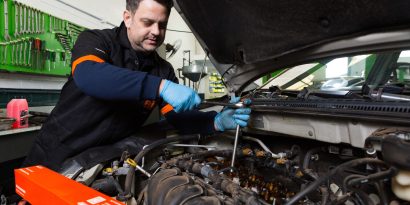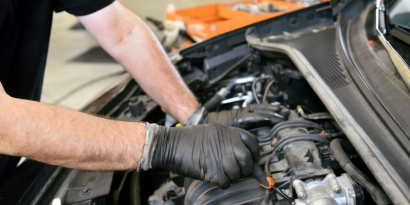The camshaft is one of the most crucial — and at the same time most neglected — components of an internal combustion engine. When camshaft wear occurs, engine performance drops significantly. This practical guide for workshop mechanics explains how to understand, diagnose, and prevent this problem.
What is the camshaft and what is its function?
The camshaft is a cylindrical rod equipped with strategically placed lobes, commonly known as cams.
- Location: In engines, it can be positioned in the cylinder head (OHC — Overhead Camshaft) or in the engine block (OHV — Overhead Valve), depending on the design.
- Main function: The camshaft controls the timing and duration for opening and closing the intake and exhaust valves. It ensures the air/fuel mixture enters and the burned gases are expelled at exactly the right moment, synchronized with the crankshaft’s movement. Essentially, it acts as the “brain” that synchronizes the engine’s breathing.
Most common symptoms of excessive camshaft wear
Wear on the cam lobes or bearings disrupts valve timing, causing various visible problems. Drivers may notice:
- Loss of power and torque: One of the most notable symptoms. The combustion chamber doesn’t fill or empty properly, reducing engine force, especially during acceleration.
- Rough or unstable idle: With altered timing, combustion in one or more cylinders may misfire or be incomplete, causing the engine to “shake” or stall at idle.
- Misfires: The engine can exhibit frequent misfires, triggering the injection module and, in some cases, illuminating the check engine light on the dashboard.
- Unusual noises from the cylinder head: A “ticking” or “clacking” sound may come from the top of the engine, caused by clearance between the cam and lifter (or rocker arm) due to material loss at the cam lobe.
- Increased fuel consumption: Inefficient combustion requires the engine to use more fuel to produce the same power.
- Difficulty starting: The engine may take longer to start, especially when hot.
Main causes of excessive camshaft wear
Camshaft wear usually results from lubrication problems, overload, or contamination.
Lubrication issues
- Low-quality or incorrect oil: Using oils that don’t meet the manufacturer’s specifications (in viscosity or anti-wear additives) prevents the formation of a protective film between the cam and lifter.
- Overdue oil changes: Degraded oil loses both lubricating and cleaning properties.
- Low oil pressure: Weak oil pumps, clogged filters, or excessive clearances in the bearings decrease the amount and pressure of oil reaching the cylinder head.
Contamination and impurities
- Clogged or expired oil filter: Metal particles or dirt in the oil act as abrasive agents, “grinding down” the material of cams and lifters.
- Fuel in the oil: Leaks in injectors or other defects dilute the oil, compromising its ability to form a protective film.
Other mechanical causes
- Damaged or misadjusted lifters: Stuck lifters or those that don’t rotate (in flat-tappet engines) concentrate contact in a single spot, accelerating wear.
- Incorrect assembly: Too much or too little tension on the timing belt/chain can generate undesired lateral loads on the camshaft.
How to prevent excessive camshaft wear
Prevention is always the most cost-effective path for the customer. As a mechanic, advise with these best practices:
Stick to a strict maintenance schedule
- Oil changes: Follow the oil change intervals recommended by the vehicle manufacturer.
- Filters: Change the oil filter at every oil change. It’s the first line of defense against abrasive wear.
Always use the correct oil (the golden rule)
Always use the specified viscosity grade and specification as outlined in the vehicle manual. Avoid cheap oils that don’t meet standards. The additive pack is vital, especially in older or high-performance engines.
Monitor oil pressure
If the vehicle comes to the workshop with noises from the cylinder head, check the oil pressure at both the pump outlet and the head. Low pressure can indicate a weak pump or excessive clearances — which need to be addressed before major camshaft damage occurs.
Check cooling system quality
Overheating quickly degrades oil and alters operating clearances, accelerating wear. Make sure the cooling system is in perfect working order.
Frequently asked questions
What causes premature camshaft wear?
Premature wear is mainly caused by poor lubrication, using inadequate oil, cooling system failures, contamination with impurities, and issues with engine assembly.
How can I identify camshaft wear symptoms?
The main signs include loss of power, increased fuel consumption, abnormal noises from the cylinder head, misfires, and rough idle.
Can engine failure be caused by a worn camshaft?
Yes. A worn camshaft disrupts valve timing, which compromises combustion and may cause severe engine malfunction.
What is the camshaft’s purpose in the engine?
It controls the opening and closing of the intake and exhaust valves, synchronizing the engine’s operating cycle with the crankshaft’s movement.
How can I prevent camshaft wear?
Follow a strict preventive maintenance plan, change the oil and filter on time, use quality parts, and monitor engine pressure and temperature.
A tip for expert mechanics!
Camshaft wear is a failure that starts slowly and manifests in expensive ways. By educating your client on the importance of using the correct oil and timely changes, you help avoid significant repairs — while also building your reputation as a preventive and reliable mechanic.
Trust parts produced with rigorous quality control, state-of-the-art technology, and a tradition in the automotive sector since 1946. At RIO, we supply camshafts, lifters, engine valves, and a full range of components for light vehicles, heavy-duty vehicles, railway, and agricultural engines.
Count on RIO’s portfolio of more than 4,000 items to guarantee performance and reliability for every kind of application. If you have any questions about RIO parts, you can contact our technical WhatsApp, and we’re ready to assist you!





